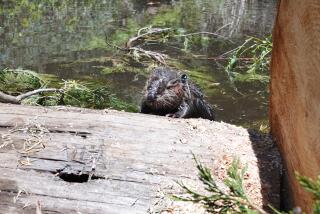Mountain beaver
- Share via
[APLODONTIA RUFA]
Hikers in the primeval forests of California’s north coast or in the Sierra Nevada may sometimes get the feeling they could encounter a prehistoric creature on the trail. Such animals exist, but they’re not fearsome beasts; rather, they’re rabbit-sized rodents hiding in underground burrows. Sole-surviving descendants of a 20-million-year-old lineage, these ancient “living fossils” are unrelated to the beavers we associate with rivers and streams, yet they share the habit of gnawing on twigs. These 2-pound rodents build complexes of burrows along stream banks and wet meadows, where hikers often break through the shallow roofs and curse their makers. Though successful enough to have survived millions of years, mountain beavers are burdened by their primitive physiology: They cannot pant or sweat, and their rudimentary kidneys are unable to concentrate urine so the animals must drink 20% of their weight in water every day. In early March, females retreat
to nests that contain up to a bushel of
vegetation to give birth to 4 to 5 young.
NATURAL HISTORY
Having evolved in a time of giant mammals, mountain beavers have carried another legacy from the dim past with them -- fleas worthy of a wooly mammoth. At one-third of an inch long, the largest fleas in the world are only found on
mountain beavers.
KEY CHARACTERISTICS
Growing 12 inches long and looking like a tailless muskrat, mountain beavers are seldom observed due to their nocturnal habits. Telltale signs of these creatures include 6- to 10-inch wide burrows, with “patios” of dirt and sometimes with “awnings” of vegetation constructed over the entrance.
More to Read
Sign up for The Wild
We’ll help you find the best places to hike, bike and run, as well as the perfect silent spots for meditation and yoga.
You may occasionally receive promotional content from the Los Angeles Times.






